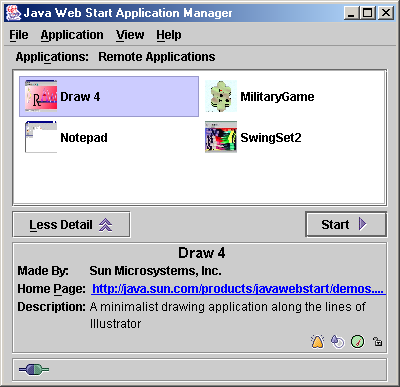Hello, I'm Michael. I'll Be Your Java Guide.
So who am I? Well, since I'm going to be your guide through the Java jungle, let me tell you a little bit about myself. My first computer was an Atari 800 with 64K of RAM and a floppy drive that held so little information that it probably would have been more efficient to just write small on its 5.25-inch paper sleeve. Later came an Amiga, then a couple of Macs, followed by more PCs than I can possibly remember. With each new system came new languages and more and more potent tools.
I have a B.S. and M.S. in Computer Science from San Diego State University, where I have also taught graduate level programming courses. In my academic career, I specialized in computer languages. Currently, I work for DivXNetworks, where I work on both the client and server side of a Video on Demand (VOD) system. Along the way, I have worked on projects for the US Navy, Boeing Aircraft, Apple Computer Europe, United Airlines, and San Diego State University. Through my career, I have learned three things about myself that I think will make me your perfect guide:
- I love to teach. Although teaching is usually associated with classrooms and ivory towers, it doesn't have to be. I enjoy teaching groups, individuals, colleagues, and friends on a day-to-day basis. Helping somebody learn a new skill or understand a new concept is truly rewarding.
- I love to write. Writing is both a creative outlet and a great way to increase your depth of knowledge about a particular topic or concept. It is nearly impossible to write about a topic, even one you know inside and out, without learning something new about it in the process.
- I'm pragmatic. I don't get caught up in hype. Although I consider myself an early adopter, I don't recommend technologies until I have used them and they have proved their worth to me. I also don't believe in promoting something just because I have knowledge or experience with it. Although I have a strong academic bias, I see the need to temper it with practicality. Because everything in our industry is in a constant state of change, we must continually adapt to and embrace change.
Java Web Start
Back in February, when Sun Microsystems released the Java2 Platform Standard Edition (J2SE) Version 1.4, there was a lot of talk about the new performance improvements, SSL, LDAP, CORBA, XML, new GUI controls, and integration with Java Web Service, but somewhere buried among a landslide of acronyms was the unassuming "new deployment options," which was Sun's underwhelming way of introducing Java Web Start to the masses. I guess you can't hype everything all the time.
Java Web Start is a simple way to make sure your users are always running on the latest version of your applications. Before Java Web Start, there were three basic ways of making sure your users were always using the latest version of your software. The first way was to deploy your applications with an HTML interface and keep all of the logic on the server side. This was an awkward solution because HTML interfaces can be limiting and slow. They also tether you to the server, keeping you from working offline. The second way was to deploy your application as an applet, but applets were often too constrained by security to be useful and required the installation of a Java plug-in. The third way to deploy, and the way I have always done it, was to embed your own version checking system within a Java application. These applications usually came with their own often-bulky-and-slow installers. These installers usually asked a series of inane questions that users usually accepted all the defaults on, assuming of course that they were able to remember what directory they had downloaded the new installer to. Then, each time the application launched, it would make a call to a server to authenticate its version number and instruct the user where to download the next version if available. When a new version of the application was available, the user would have to download and run the new installer and yet again answer the same set of inane questions.
Java Web Start takes a cleaner approach. With Java Web Start, you have one application--the Java Web Start Application Manager--on each client machine that manages all that client's Java applications. You can launch an application by selecting it from within Java Web Start Application Manager, by clicking on a link on a Web page, or by using a shortcut made by the Java Web Start Application Manager (shown in Figure 1 below). Any of these actions launches Java Web Start, if it isn't already running, and has it query the Web for updates on behalf of the application. If an update is not available or if a network connection is not available, then the application launches with its currently downloaded version. If an update is available, Java Web Start downloads the application and then launches it. Although this doesn't sound that different on the surface, the user experience is excellent. Users see the application they want to run in any one of several familiar places. And when they click on it, they are always running the latest version.

Figure 1: The Java Web Start Application Manager
Java Web Start Application Manager has several other useful advanced features, such as being able to configure which Java Runtime Environment to associate with each application and the ability to set up proxies for Web connections. If your users are used to desktop or start menu shortcuts for starting their applications, you can configure Java Web Start Application Manager to create them automatically. Also, applications can be digitally signed, and the user will be prompted to manually grant or deny permission to an application that attempts to violate the standard "sandbox" security profile. Last but not least, you can also configure each of your applications to launch with a console window and/or log all output to a file. This can be very handy for debugging deployed applications. You can have a user turn on logging, run through a script, and then email you the log file--all with just a few simple clicks.
This all sounds great, but are there any disadvantages? Well, I have encountered only one, and it is pretty minor. In order to bootstrap all of this automatic functionality, you of course have to install Java Web Start using one of those inane question-asking installers. The good news is that J2SE Version 1.4 installs it automatically for you; it even puts a shortcut on your desktop. Or if you want to use Java Web Start without installing J2SE Version 1.4, you can install just Java Web Start from here.
So you're familiar with Java Web Start, which on the surface seems like a pretty trivial utility, but it allows you to drastically improve your end users' experience. It is packed with features that enable you to easily manage how Java applications are deployed and updated. It also allows you to use true Java applications that are not bogged down with version checking code and installers. In addition, and most importantly, it provides a better user experience than applications written using HTML interfaces.
Where Do We Go from Here?
It's an exciting time to be a Java programmer. Gone are the days of worrying about major API and language specification changes. Also gone are the days of wondering if Java was for real or just an interesting fad. The tools are powerful, and the extensions and utilities are rich and mature. Java has scaled up to the largest enterprise application servers and down to cell phones and PDAs, and it also runs on everything in between. So what part of the Java jungle should we explore together next? Here are just a few ideas:
- Java IDEs
- Java Web Services vs. .NET
- SOAP
- Java and XML
- Sun ONE Studio
- Java Card
- JavaMail
- Tips on moving up to J2SE Version 1.4
- Java style guides
- Code construction
- Refactoring
- Reflection
- SQLJ
- Extreme programming
- Design patterns
If you don't see the topic you are most interested in on the list, email it to me at
Michael J. Floyd is a Senior Software Engineer and Extreme Programmer for DivXNetworks and consultant to San Diego State University. He can be reached at












 Business users want new applications now. Market and regulatory pressures require faster application updates and delivery into production. Your IBM i developers may be approaching retirement, and you see no sure way to fill their positions with experienced developers. In addition, you may be caught between maintaining your existing applications and the uncertainty of moving to something new.
Business users want new applications now. Market and regulatory pressures require faster application updates and delivery into production. Your IBM i developers may be approaching retirement, and you see no sure way to fill their positions with experienced developers. In addition, you may be caught between maintaining your existing applications and the uncertainty of moving to something new. IT managers hoping to find new IBM i talent are discovering that the pool of experienced RPG programmers and operators or administrators with intimate knowledge of the operating system and the applications that run on it is small. This begs the question: How will you manage the platform that supports such a big part of your business? This guide offers strategies and software suggestions to help you plan IT staffing and resources and smooth the transition after your AS/400 talent retires. Read on to learn:
IT managers hoping to find new IBM i talent are discovering that the pool of experienced RPG programmers and operators or administrators with intimate knowledge of the operating system and the applications that run on it is small. This begs the question: How will you manage the platform that supports such a big part of your business? This guide offers strategies and software suggestions to help you plan IT staffing and resources and smooth the transition after your AS/400 talent retires. Read on to learn:
LATEST COMMENTS
MC Press Online